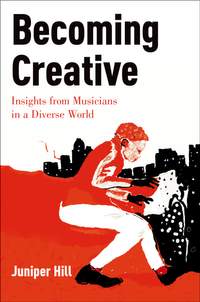Book
$128.50Special import
Contents
- Table of Contents
- Acknowledgments
- List of Figures
- Chapter One:
- Interpreting Creative Experience Across Diverse Musical Communities
- 1.1. Introduction
- 1.2. What does it mean to be creative?
- An experiential model of musical creativity
- Generativity
- Agency
- Interaction
- Nonconformity
- Recycling
- Flow
- Value as a problematic component of creativity
- 1.3. Creativity as socially undesirable behavior: some theoretical insights
- Social pressures to conform
- Internalizing motivations not to be creative
- 1.4. Common enablers and inhibitors of creativity: an overview of chapters
- 1.5. Learning from the experiences of musicians: methodology
- 1.6. Contrasting musical communities: the case studies
- The allure of Helsinki, Cape Town, and Los Angeles as research sites
- Urban distinctions
- Cross-cultural comparisons of classical, jazz, and folk music communities
- Chapter Two:
- Developing Creativity Enabling Skills
- 2.1. Introduction to creativity enabling skills
- 2.2. Technique
- The myth of technical mastery as prerequisite for creativity
- Overemphasis on technique
- Correct technique as conformativity or toolbox
- 2.3. Aural skills
- Building aural skills through oral transmission
- Lack of aural skills as inhibiting
- Concerns about oral transmission and imitation
- 2.4. Vocabulary and memory facility
- Building vocabulary for idiomatic creative activities
- Human memory as facilitator of creativity
- Oral versus written culture
- Reviving oral culture and unfixing notation
- A critique of pattern manipulation as (un)creative
- 2.5. Syntax and the ability to apply music theory
- 2.6. Decision-making skills
- Lack of decision-making skills as inhibiting
- Approaches for fostering decision-making skills
- 2.7. Self-assessment skills
- 2.8. Summary of developing creativity enabling skills
- Chapter Three:
- Developing Psychological Enablers and Inhibitors of Creativity
- 3.1. Introduction to psychological enablers and inhibitors of creativity
- 3.2. Beliefs about talent and potential
- Western attitudes toward talent and their impacts
- South African attitudes toward musical and creative potential and their impacts
- 3.3. Role models
- Identification with role models and sense of potential
- Role models as conveyors of norms and permission
- 3.4. Assessment and feedback
- Positive feedback
- Constructive critical assessment
- Destructive feedback
- Anticipating feedback
- Self-judgment
- 3.5. Values and attitudes
- Mistakes and Perfectionism
- Originality versus recycling
- 3.6. Summary of psychological enablers and inhibitors
- Chapter Four:
- Accessing the Opportunity, Permission, and Authority to be Creative
- 4.1. Opportunities and barriers in creative development: social inequalities
- Prejudice and internalized perceptions of limited potential
- Economic inequalities in music learning
- 4.2. Opportunities and barriers in creative work: economic pressures
- Private gigs, corporate sponsorship, and neoliberal policies in Cape Town
- Working for the music, television, and film industries in Los Angeles
- State support for the arts in Helsinki
- Policies, markets, motivation, and education
- 4.3. Authority, permissions, and prohibitions: who's allowed to create what music?
- Codifying rules for newcomers and restricting outsiders
- Stylstic boundaries and the politics of race, class, and cultural imperialism
- Internalizing musical attitudes and practices as moral values
- 4.4. Summary of societal enablers and inhibitors of creativity
- Chapter Five:
- Overcoming Inhibitors of Creativity
- 5.1. Mechanisms for overcoming inhibitors of creativity
- The safe transgression of comfort zones
- 5.2. Formal methods for enhancing creative agency: courses and programs
- Safety and emotional support
- Facilitating composition and improvisation within an idiom
- Free improvisation, experimentalism, and the breaking of convention
- Multiple modes of expression: singing, multi-instrumentalism, dance, and theatre
- Exposure, facilitator expectations, and validation
- 5.3. Informal strategies for overcoming creative hurdles: individual journeys
- Tuomas
- Jackie
- Kyle
- Anja
- Juniper
- 5.5. Conclusions on increasing creative agency
- Musicians Interviewed
- References




